- Details
- Category: Astronomical Events
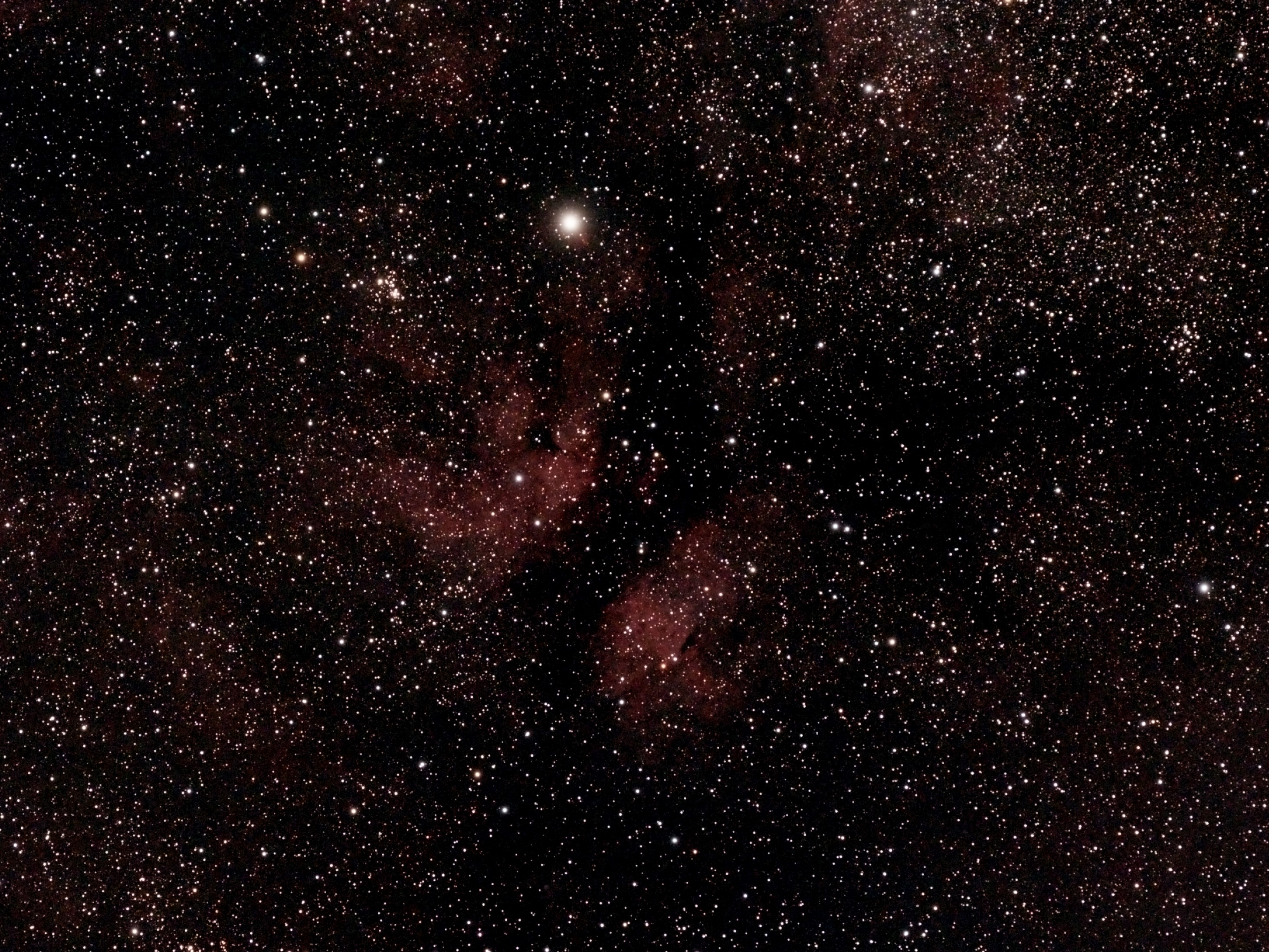 photo by Thomas Trostel photo by Thomas Trostel18 x 300 second exposures,Celestron AVX and Cannon EOS-R
Using Baader Moon & Skyglow Filter
|
Many sky enthusiasts such as Thomas Trostel love phtographing the heavens. Shown here is the nebulosity around Gamma Cygni (IC1318) taken near his home in Reston. But light pollution is making it increasingly difficult to find a dark sky.
Turner Farm Observatory Park is one of the best places to observe and photograph the night sky and recognition with the International Dark Sky Association (IDA) is underway by the Fairfax County Park Authority.
The Analemma Society has made public observing an important resource at Turn Farm Park with a collection of telescopes in the Roll-Top Observatory now available to the public every Friday night, weather permitting. Equipment was made available through Mastenbrook Grants and the generous donation by Jean and Ric Edelman.
Efforts are underway led by by Andrew Hayes to purchase a new telescope with CCD imager and filters for remote control in the Remote Astronomical Telescope Observatory (RATO) next to the Roll Top Observatory and Class Room. This will expand capabilities for public imaging of the universe. Details of how this will come about is still in the planning stages. But remote views of the deep heavens is coming to a computer near you.
And more to come. Radio Jove and the One Square Meter Radio Telescope are being establishing to monitor the sun (solar flares), planets (Jupiter and its moon Io), and our Milky Way Galaxy (observing the 21cm radio transmission of hydrogen as a tracer of the spiral arms). Stay tuned for participating in these exciting observations.
- Details
- Category: Astronomical Events
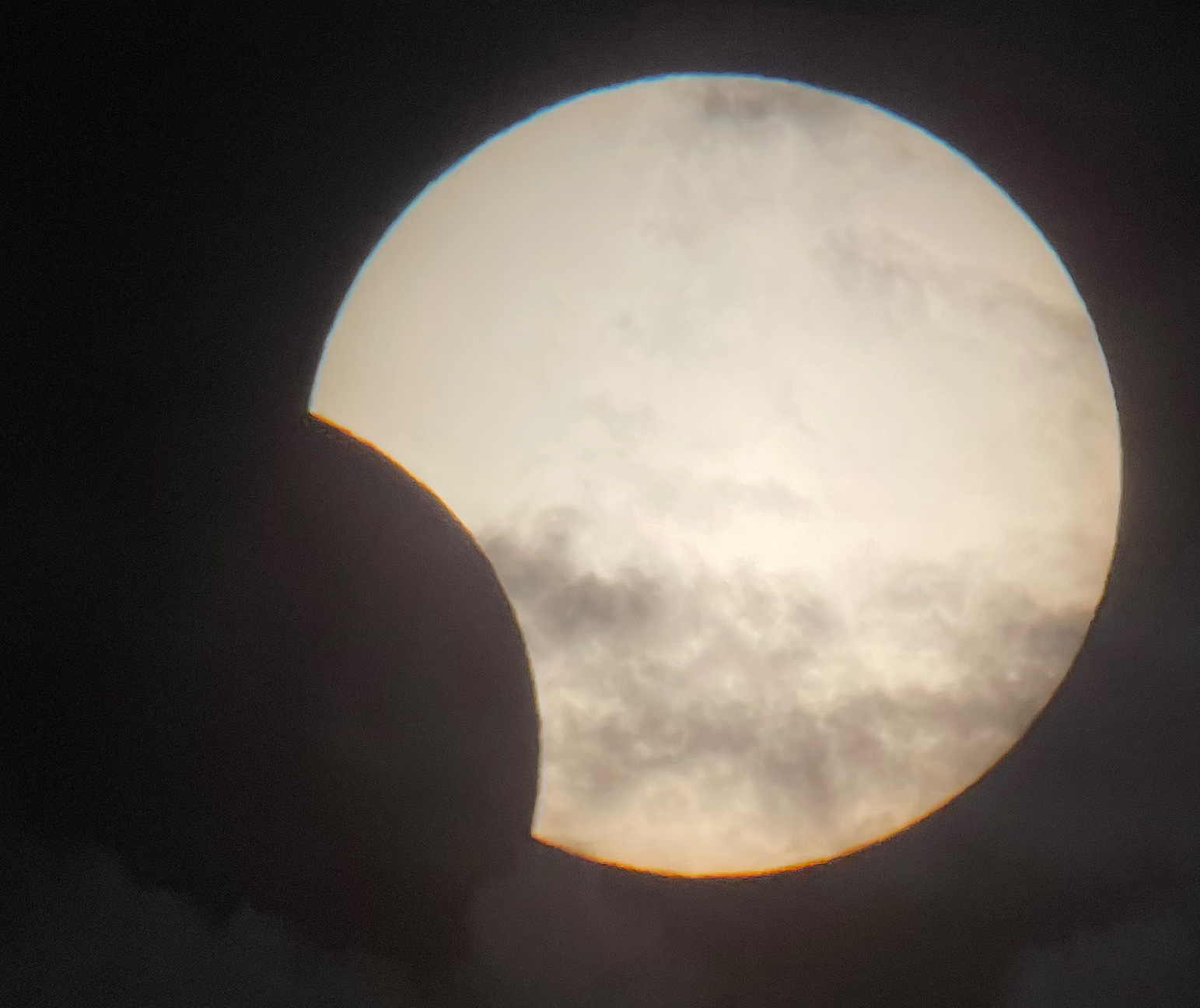 |
| Bill Burton Photo using an iPhone 12 through a Celestron C90 Maksutov with a Thousand Oak Solar Filter-June10, 2021 |
Before sunrise on June 10th, Analemma Society volunteers Alan Figgat, Dan Ward and wife Donna, Mary Blessing, Bill Burton and wife Laurel Wanrow, and Daniel Vrolijk prepared the Turner Farm Park Observatory's coronograph to view the eclipse and their own telescopes with protective filters. In Virginia the sun rose at 5:45am EDT with eclipse maximum at 5:48am and the last moon contact was 6:29am. Despite the overall poor weather forecasts, the final forecasts did predict breaks in the clouds around sunrise. That is exactly what happened.
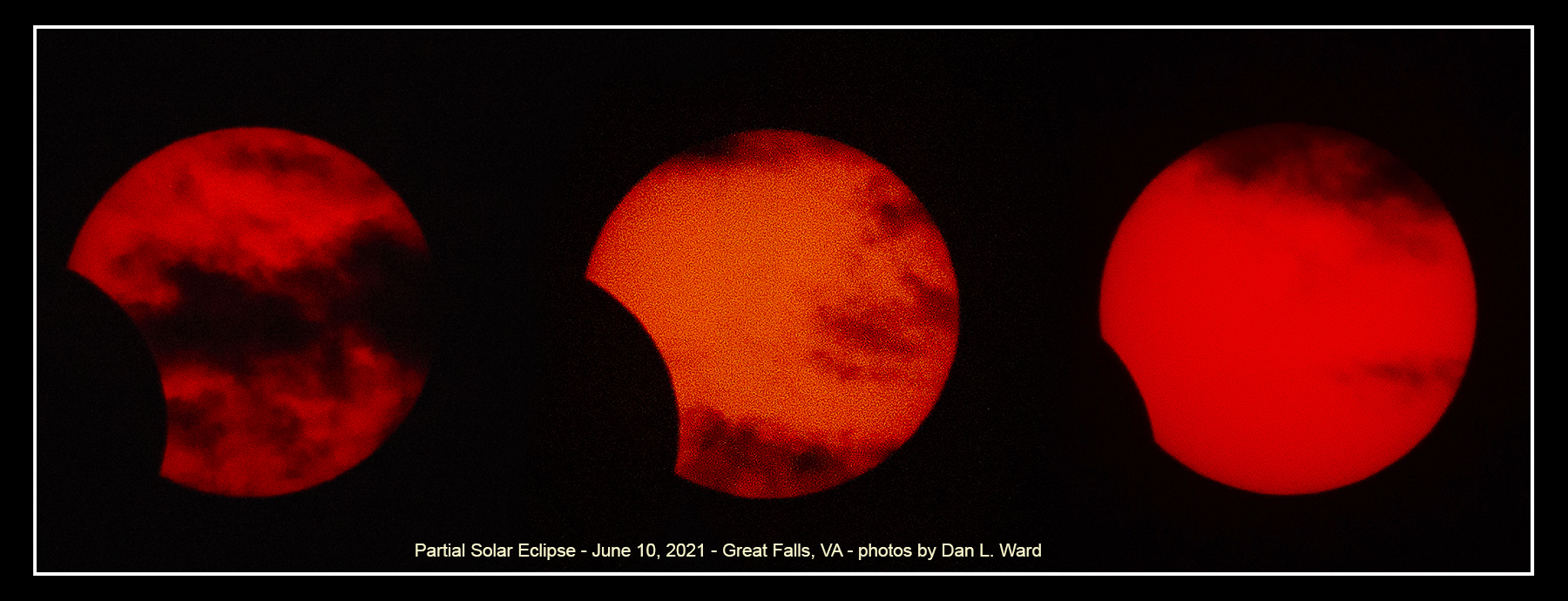

There was a light public turnout, probably due to the poor weather forecasts and the early morning hour. However, several parents with children came at the early hour to oberve the celestical event of the moon blocking about 65% of the sun. Clouds blocked the eclipsed sun for a few minutes as it cleared the treeline, then gaps and clearing of the clouds provided dramatic views of the partially eclipsed sun with clouds passing in front. With the return of public access to the Roll-Top building, Analemma Society volunteers showed visitors telescopic views of Jupiter and Saturn before and after sunrise.
Meanwhile Bob Kellogg was in upstate New York and had the same weather of hazy clouds with 80% of the sun blocked. However, just before sunrise there was a spectacular sun dog making an almost complete Jacob's Ladder. (sun pillar).
- Details
- Category: Astronomical Events
Who let the dogs out? This is a springtime phenomenon of "mock suns" called sun dogs created by ice crystals highin the atmosphere. If you look closely at Dr. Jeff Kretsch's photo of the RATO tower and just over the roof of the Roll-Top Observatory is a bright spot. That's a sun dog. Usually they come in pairs to the left and right of the sun at an angle of 22 degrees and if you look carefully over the trees at right, youll see a faint second sun dog. Sometimes a halo or partial halo can be seen around the sun as well. This photo was taken on March 30, 2021. Read more at https://en.wikipedia.org/wiki/Sun_dog

- Details
- Category: Astronomical Events
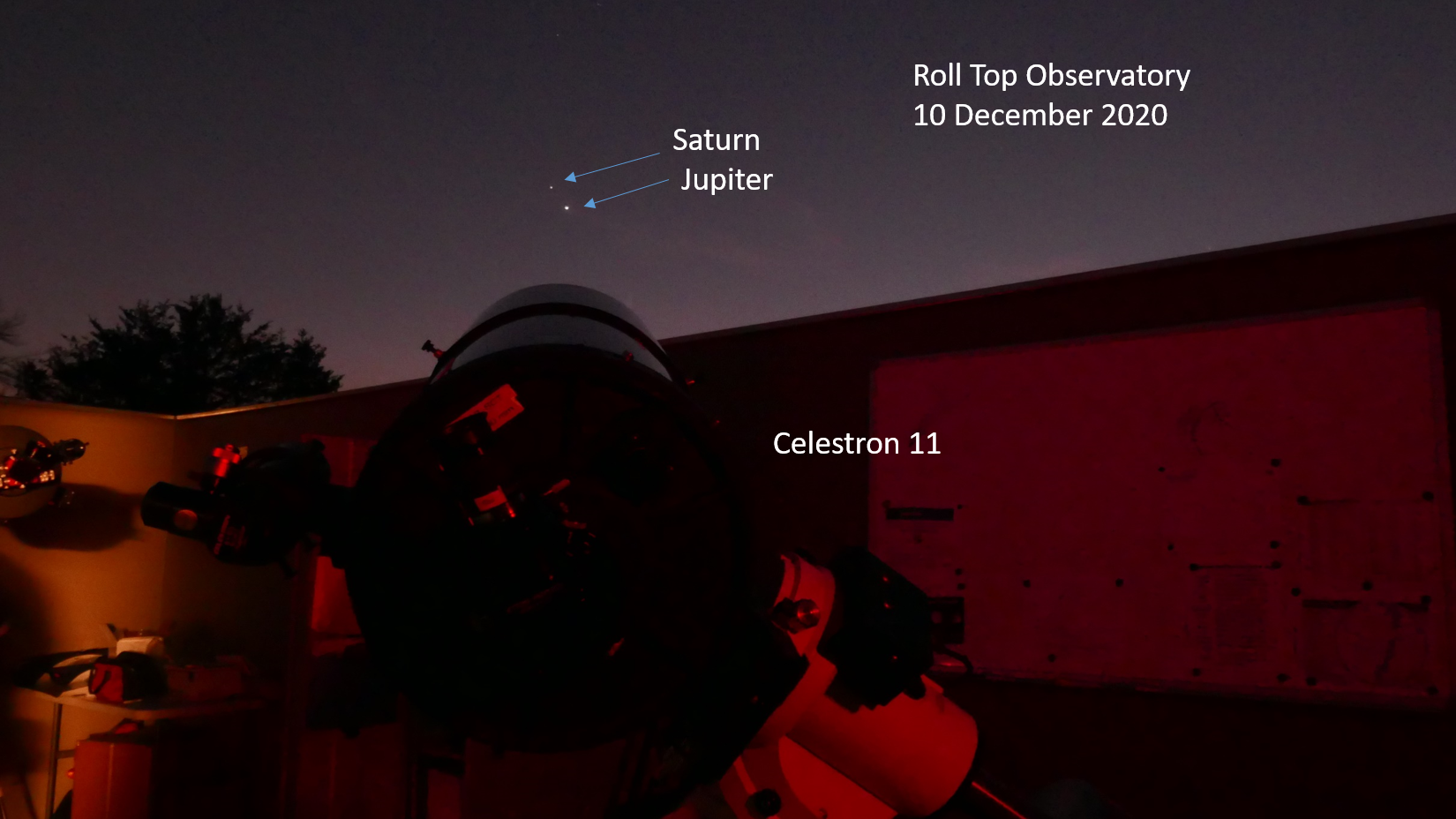 The "Great Conjunction" of Jupiter and Saturn on December 21st means that these two planets will appear in the sky very close together...so close that you will be able to see both in a view through a small telescope. The last time these planets appeared this close was in 1623, but the sun was in the way. So the last time these planets were actually seen this close was in 1226. Yes, this is a rare event, and hence the prefix "Great" in front of the word conjunction. It has been called "The Christmas Star" by news reports, and is certainly not the star of Bethlehem (remember that Harod couldn't see the star...everyone can watch Jupiter and Saturn). Don't panic if it is cloudy on the 21st. Go out a couple of days before the 21st and watch each clear night. Use binoculars or a small telescope for a great view.
The "Great Conjunction" of Jupiter and Saturn on December 21st means that these two planets will appear in the sky very close together...so close that you will be able to see both in a view through a small telescope. The last time these planets appeared this close was in 1623, but the sun was in the way. So the last time these planets were actually seen this close was in 1226. Yes, this is a rare event, and hence the prefix "Great" in front of the word conjunction. It has been called "The Christmas Star" by news reports, and is certainly not the star of Bethlehem (remember that Harod couldn't see the star...everyone can watch Jupiter and Saturn). Don't panic if it is cloudy on the 21st. Go out a couple of days before the 21st and watch each clear night. Use binoculars or a small telescope for a great view.
While calibrating telescopes at the Roll-Top Observatory at Turner Farm Observatory Park, Jeff Kretsch took the following photo at right:
- Details
- Category: Astronomical Events
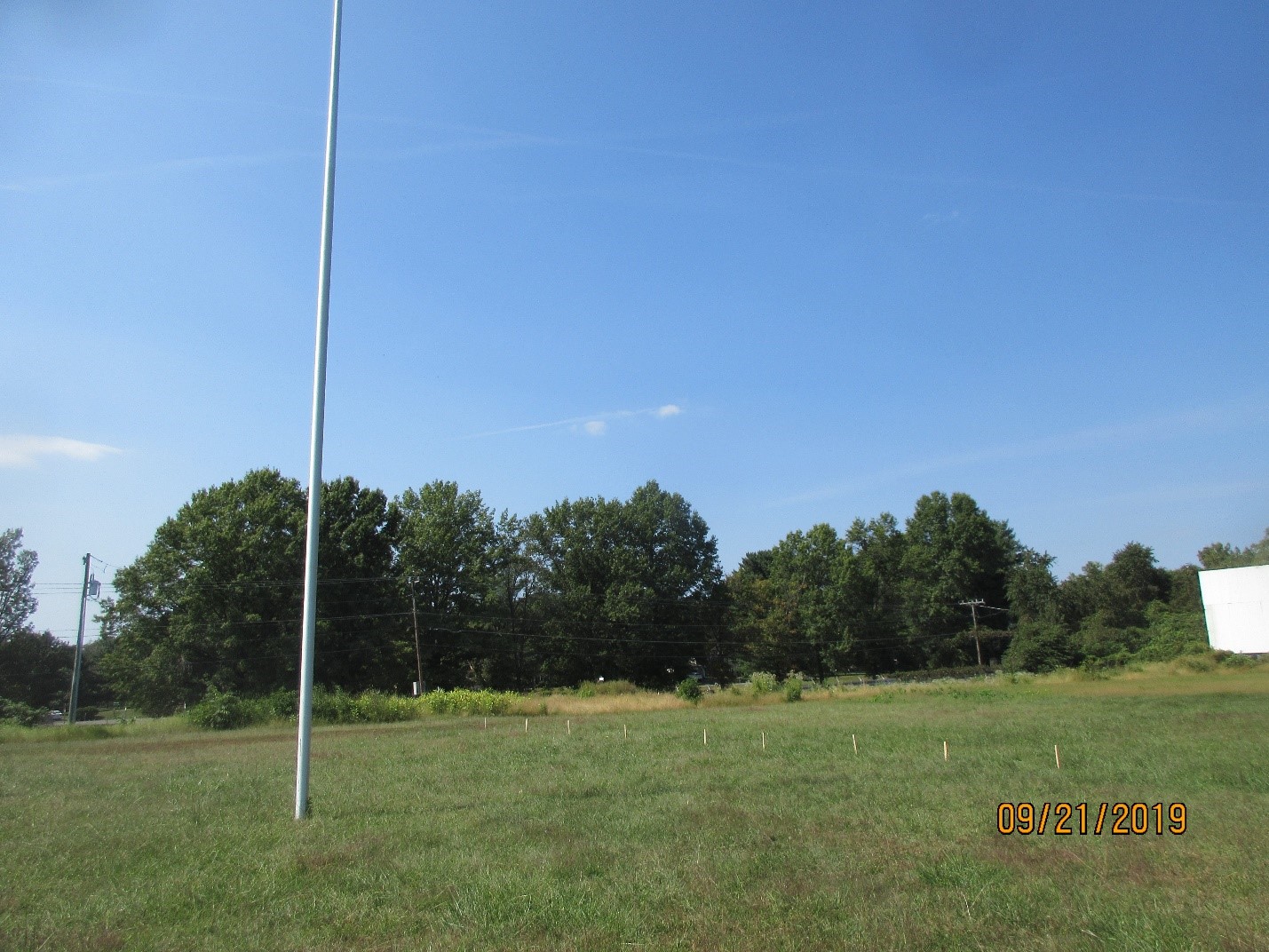 Last year during the fall equinox at Turner Farm we followed the tip of the shadow from our flagpole in the field adjacent to the Roll-Top and RATO observatories. Every half hour we put a stake in the ground where the shadow tip fell. Amazing...on the equinox the shadow follows a straight line from west to east. On other days of the year the shadow follows a bent (hyperbolic) path. You can see the stakes put into the ground at half hourly intervals form a line.
Last year during the fall equinox at Turner Farm we followed the tip of the shadow from our flagpole in the field adjacent to the Roll-Top and RATO observatories. Every half hour we put a stake in the ground where the shadow tip fell. Amazing...on the equinox the shadow follows a straight line from west to east. On other days of the year the shadow follows a bent (hyperbolic) path. You can see the stakes put into the ground at half hourly intervals form a line.
At the top of the flagpole is a small ball. You would think that it is easy to look for its shadow and mark the shadow tip on the ground. But a strange thing happens. It is very much like a partial solar eclipse (and remember NEVER look directly at the sun). In this case it is the ball on the flagpole blocking part of the sun. Because they appear as different sizes, sunlight "leaks" around the flagpole ball and the shadow on the ground is washed out and indistinct. 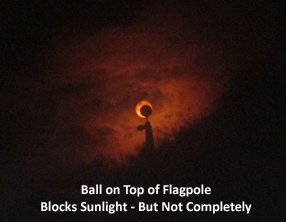 This is a penumbral shadow in technical parlance and makes the shadow hard to see. For our flagpole at a time near noon, the ball appears almost the size of the sun and the shadow is sharper and easier to see and mark with a stake.
This is a penumbral shadow in technical parlance and makes the shadow hard to see. For our flagpole at a time near noon, the ball appears almost the size of the sun and the shadow is sharper and easier to see and mark with a stake.
Now let’s go to a smaller scale, something that you can do in your backyard. We'll show you an example of what we did using the observatory's sidewalk where we have power piers that are just short of 3-feet high. On the equinox we marked the shadow tip with chalk at different times. The chalk is hard to see in the photo, so we enhanced it a bit with purple dots. The photo shows the morning shadow traveling west to east as the ten o'clock hour advances. The dots form a straight line.
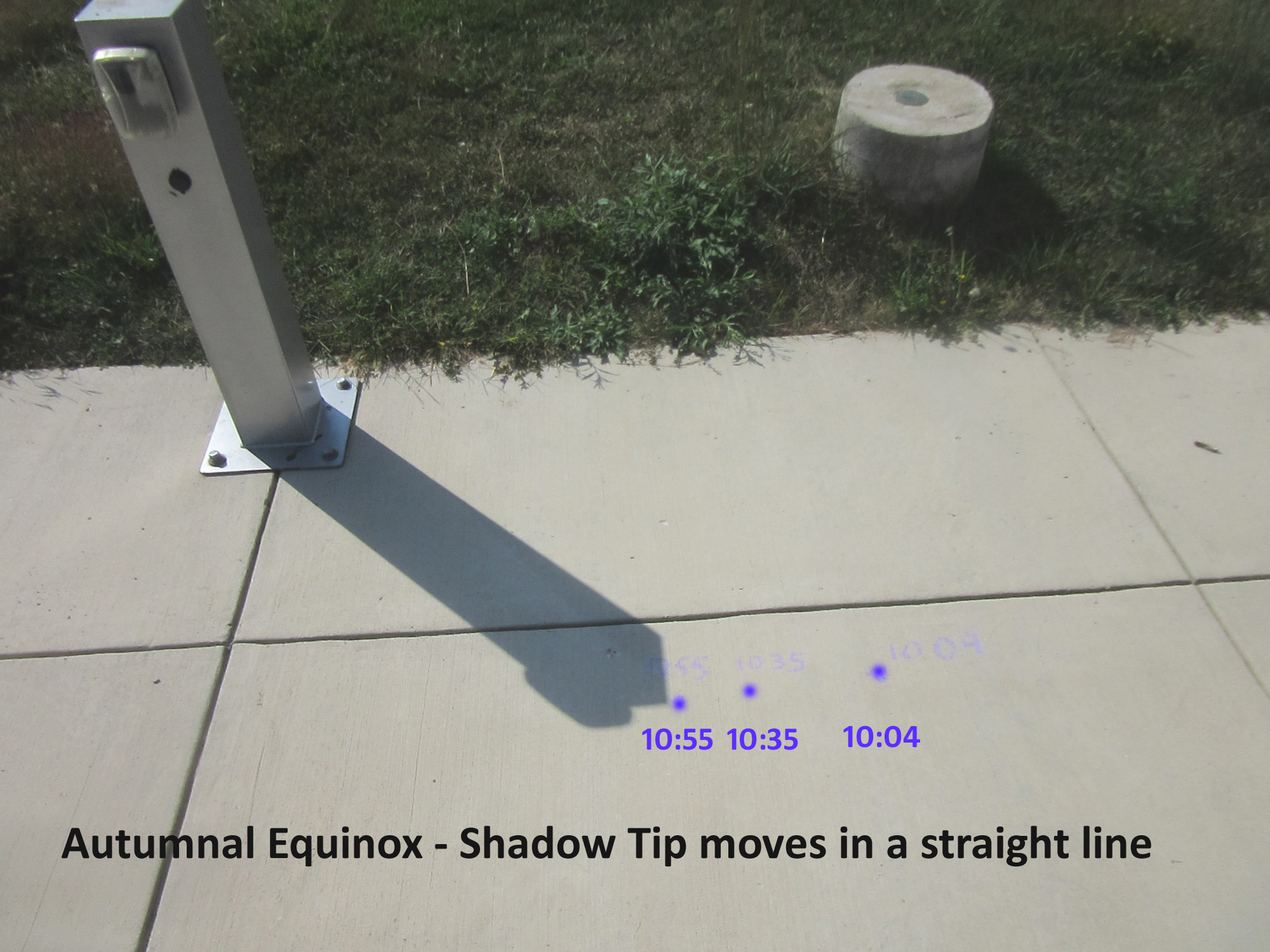 You can make the same observations using a stick in the ground and follow the tip of the shadow through the day, putting a pebble or a penny down at half-hour intervals. You too can then “draw a straight line” to show your equinox shadow’s travel.
You can make the same observations using a stick in the ground and follow the tip of the shadow through the day, putting a pebble or a penny down at half-hour intervals. You too can then “draw a straight line” to show your equinox shadow’s travel.
So why does the shadow move in a straight line? Imagine that you have a great big ball with its center at the top of your stick. This is the celestial sphere with its axis pointed to the north celestial pole. On the equinox the sun is on the celestial equator, sort of like a belt going around the middle of the sphere. During the day the sun travels from east to west on that belt as the whole celestial sphere turns. (Of course you and I know it is the earth turning, not the sun).
But that celestial equator when projected to the ground is seen on edge. That means that it doesn't look like a circle, it looks like a line...a straight line. And that's what happens to the stick's shadow. It follows that projection following a straight line.
At other times of the year the sun is either north or south of the celestial equator and no longer follows a "great circle" but appears to follow a small circle on the sphere. (The smallest circles...and you can see them on some globes of the earth ...are called the Tropic of Cancer and the Tropic of Capricorn for the sun's summer and winter solstices). Those circles when projected onto the ground form hyperbolas.
During the summer the hyberbola shadow line curves downward to the south, and during winter the path of the shadow will have a morning and evening end that points upward toward the north. Only on the spring and fall equinox does the sun's daily (diurnal) shadow travels in a straight west-east line. Try it yourself on the equinox occuring on Tuesday, September 22, 2020.
Page 5 of 7

